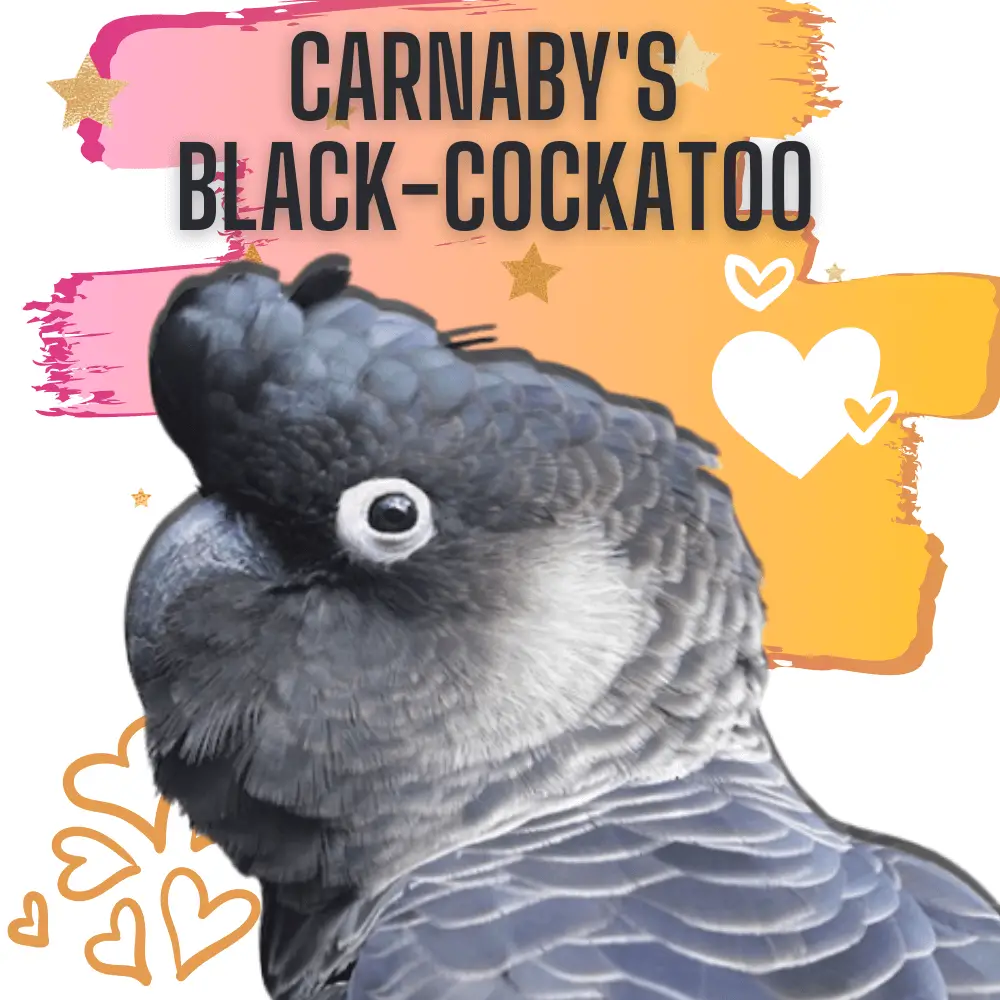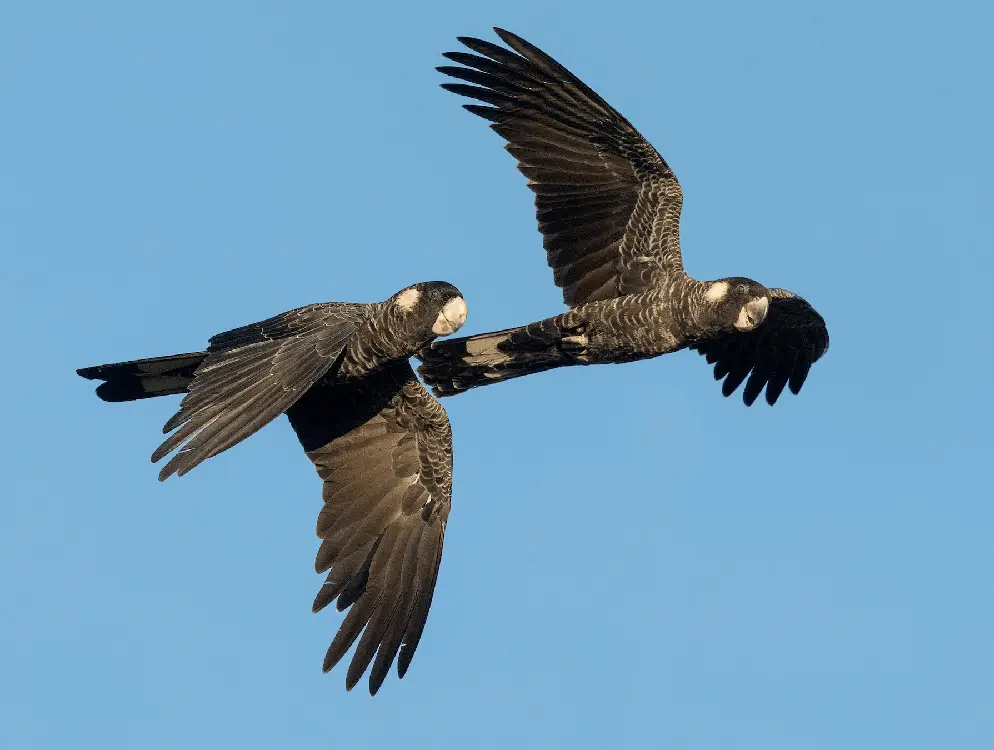
Carnaby’s Black-Cockatoo: 55–60 cm; 580–770 g; culmen 41–46 mm (mean 44·2 mm). Body plumage dusky black with buff margins to feathers;
off-white patch on ear-coverts; tail has subterminal white panels, but central two feathers all black; eye dark brown; feet grey-brown. Sexes similar but periophthalmic skin pinkish-red in male, dark grey in female;
bill grey-black in male, bone-colored in female; female has larger ear patch. Juvenile resembles female; no immature plumage, immatures resembling adults except that males take at least a year to attain adult bill color.
Calyptorhynchus latirostris Scientific name definitions
- EN Endangered
- Names (14)
- Monotypic
Systematics History
Closely related to Z. funerea and Z. baudinii. Long considered conspecific with latter, mainly on account of identical plumages, but currently treated as separate because present species’ ecology is quite different and a bill significantly shorter than that of Z. baudinii;
difficulty in field identification, compounded by a long history of conspecific treatment, has led to uncertainty regarding limits of range in the area of overlap, and to the publication of some inaccurate maps.
Exhaustive analysis of all available specimens of taxa in the present genus suggested that latirostris was so similar to South Australian Z. funerea that it might perhaps be treated as a race of latter. Monotypic.
Subspecies
Monotypic.
Distribution
Carnaby’s Black-Cockatoo: Inland and coastal SW Australia (from Kalbarri to Esperance), in 300–750-mm rainfall zone; breeds mainly between Three Springs and the Stirling Range and from Cataby to Tone R in W.
Carnaby’s Black-Cockatoo Habitat
Sandplain heath or shrubland and eucalypt woodlands, especially of wandoo (Eucalyptus wandoo) and salmon gum (E. salmonophloia), with annual rainfall in the range 300–750 mm.
Also forages in wetter marri (Corymbia calophylla), karri (Eucalyptus diversicolor), and jarrah (E. marginata) woodland in the non-breeding season.
Movement

Carnaby’s Black-Cockatoo
Once young fledge, all members of the family leave the nesting area and join a foraging flock that moves nomadically; inland nesters move to wetter coastal areas,
and flocks of several thousand birds may aggregate in coastal pine forests (such behavior unknown prior to 1930s). These flocks start to disband prior to the onset of the next breeding season.
Don’t make them go extinct – Saving Perth’s Carnaby’s Black-Cockatoo [Full version]
SOURCE: BirdLife Australia
Carnaby’s Black-Cockatoo Diet
Uses short massive bill to shred cones of the native Banksia and Dryandra species and also the introduced Pinus radiata; after shredding, the seeds are eaten. In non-breeding season sometimes forms foraging flocks with C. banksii .
What do wild cockatoos eat
Breeding Carnaby’s Black-Cockatoos, which typically forage within 12 km of the nest, also eat the flowers of a wide variety of heathland plants and others, including Allocasuarina, Hakea, Grevillea, and Corymbia calophylla , as well as insect larvae. Usually feeds in a tree or shrub, but will forage on the ground, as when eating wild geranium (Erodium).
Sounds and Vocal Behavior
Vocalizations differ slightly from Z. baudinii: the main call is high-pitched, drawn-out “whee-la”, with second syllable slightly longer than that of baudinii, while alarm call is harsh screech likened to that of Cacatua galerita and fledged young give constant harsh wheezing calls.
Carnaby’s Black-Cockatoos enjoying bird bath
SOURCE: BIBY TV
Breeding
Laying Jul–Nov, or Aug–Dec. Pair-bonds are typically permanent, but nest-sites (selected by females) can vary between years.
Carnaby’s Black-Cockatoo Females, especially, are highly territorial and aggressive, thus many potential nest sites may remain unoccupied. Nest is a bed of woodchips in a large tree-hollow, 2–20 m above the ground, usually with an entrance at least 18 cm in diameter, at least 15 cm deep, and widening to 35 cm at the base.
Clutch of 1–2 white eggs (mean 1·7–1·8, first egg larger than second); incubation 28–29 days; female alone incubates eggs and broods nestlings, during which time she is fed by male; chick has yellow or white down;
after 4–5 weeks, nestling is left alone while female forages with male, and from then on both members of pair feed nestling; rate of feeding declines during very hot weather and in areas where food is less abundant;
fledging at 10–11 weeks. Only rarely do both nestlings survive at a nest, the second to hatch usually dying within 48 hours.
In one study in the 1970s, 7% of recorded nesting attempts failed due to unguarded eggs being damaged by Eolophus roseicapilla, which in some areas competes with present species for nest-holes;
elsewhere 71–77% of eggs hatched, although total clutch failure was 27–30%, and fledging rates from egg and hatching stages were just 20–35% and 29–46%, respectively, while the mean number of young produced per nest was 0·34–0·63.
Carnaby’s Black-Cockatoos do not breed until four years old and customarily remain with their parents for the first year. The oldest known female in wild was 19 years old.
Conservation Status

Carnaby’s Black-Cockatoo
ENDANGERED. CITES II. Although large numbers are still seen around Perth, Western Australia, the proportion of these that are juveniles from recent breeding is not known. Total population estimated at 9000–35,000 birds in 1977, b
ut although thought to number c. 40,000 in 2007, scattered across four subpopulations (northern Wheatbelt, upper southern Wheatbelt, south-eastern Wheatbelt, and Esperance coast), conservation status has been recategorized as Endangered (previously regarded as Vulnerable.
Why are black cockatoos endangered
The Carnaby’s Black-Cockatoo breeding population is now mainly concentrated between Three Springs and the Stirling Range and areas to W (Cataby to Tone Rover).
A major concern is that breeding distribution has shrunk by one third in the past 30 years (and declines appear to be ongoing according to most recent data),
following the clearing of native vegetation for wheat farming (in some areas more than 90% has been lost since the 1950s) and extensive fragmentation (and degradation by domestic livestock) of remaining habitat, with productive feeding areas increasingly distant from nesting sites.
In many cases, such problems could have been avoided, or potentially resolved, through the preservation or restoration of corridors of native vegetation.
Nest-hollow availability, though not currently limiting, is likely to become so in the future with feral bees and other cockatoos competing successfully for hollows,
and it has been suggested that suitable nest-sites in currently extant areas might be virtually non-existent in some areas by the late 21st century, although replanted natural eucalypt woodland might by then offer viable alternatives.
The concern of foresters that they were not able to harvest pine cones for seed in competition with present species was allayed by producing seed cones in special remote seed orchards, where fertile cones mature on young trees not visited by cockatoos;
it was also found that sufficient seed could easily be gathered from the ground below where the cockatoos had been feeding and had dropped many partially eaten cones.
Of present concern is that many pine plantations, on which birds depend in the non-breeding season, are reaching maturity and are set for wholesale harvest.
Nest-robbing for domestic trade has declined, but damage to nest hollows occurs when birds were taken for illegal export. Natural events, such as disease and exceptional climatic events (including heatwaves and hailstorms), have killed significant numbers of birds in recent years.
Carnaby’s Black Cockatoos in crisis
SOURCE: WWF-Australia




















